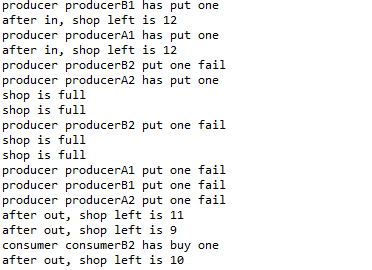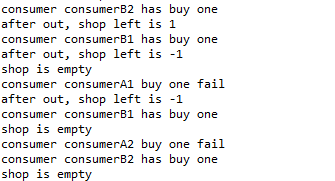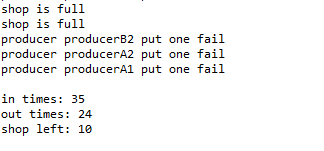Java多线程之生产者和消费者模式
这几天学习了下JUC的基础知识,并实现了经典的生产者和消费者模型。生产者和消费者广义上可以指数据的产生和数据的使用者,可以用在很多场景中。这里只是做了简单的实现。
公共类和方法
本文中的生产和消费的模型,主要是指 生产 => 商店 => 消费 这样的模型。
相关文章网上有很多,实现具体细节也不一样。
生产者和消费者的可以使用自定义的粗糙实现,也可以使用JavaAPI提供的JUC相关类。
商店
商店的接口(也可以是抽象类)Shop:1
2
3
4
5
6
7
8
9
10
11
12
13
14
15
16
17
18
19
20
21
22
23
24
25
26
27
28
29
30
31
32
33
34
35
36
37package com.chain.blog.test.day02;
/**
* 商店接口
*
* @author Chain
*
*/
public interface Shop {
/**
* 最大的商品库存数
*/
public static final int MAX = 10;
/**
* 最小的商品库存数
*/
public static final int MIN = 0;
/**
* 查找商品的库存
*
* @return
*/
public int now();
/**
* 商店进货
*/
public boolean in();
/**
* 商店卖货
*/
public boolean out();
}
接下来是生产者和消费者,在这里我使用了CountDownLatch,用于最后的main线程的统计已生产和已消费的数量。
在这里,所有的生产者和消费者均尝试生产和消费20次。
常量
存储在Constant接口里:1
2
3
4
5
6package com.chain.blog.test.day02;
public interface Constant {
public static final int TIMES = 20;
}
生产者
生产者模型Producer:1
2
3
4
5
6
7
8
9
10
11
12
13
14
15
16
17
18
19
20
21
22
23
24
25
26
27
28
29
30
31
32
33
34
35
36
37
38
39
40
41
42
43
44
45
46
47
48
49package com.chain.blog.test.day02;
import java.util.concurrent.CountDownLatch;
/**
* 生产者
*
* @author Chain
*
*/
public class Producer implements Runnable {
private Shop shop;
private CountDownLatch latch;
public Producer(Shop shop, CountDownLatch latch) {
this.shop = shop;
this.latch = latch;
}
public void run() {
try {
for (int i = 0; i < Constant.TIMES; i++) {
try {
// 随机暂停一段时间,模拟不同的情况
// Thread.sleep((int) (Math.random() * 301 + 100));
Thread.sleep(100);
} catch (InterruptedException e) {
}
put();
}
} finally {
latch.countDown();
}
}
private void put() {
boolean res = shop.in();
if (res) {
System.out.println("producer " + Thread.currentThread().getName() + " has put one");
} else {
System.out.println("producer " + Thread.currentThread().getName() + " put one fail");
}
}
}
消费者
消费者模型Consumer:1
2
3
4
5
6
7
8
9
10
11
12
13
14
15
16
17
18
19
20
21
22
23
24
25
26
27
28
29
30
31
32
33
34
35
36
37
38
39
40
41
42
43
44
45
46
47
48
49
50
51
52package com.chain.blog.test.day02;
import java.util.concurrent.CountDownLatch;
/**
* 消费者
*
* @author Chain
*
*/
public class Consumer implements Runnable {
private Shop shop;
private CountDownLatch latch;
public Consumer(Shop shop, CountDownLatch latch) {
this.shop = shop;
this.latch = latch;
}
public void run() {
try {
for (int i = 0; i < Constant.TIMES; i++) {
try {
// 随机暂停一段时间,模拟不同的情况
// Thread.sleep((int) (Math.random() * 301 + 100));
Thread.sleep(300);
} catch (InterruptedException e) {
}
buy();
}
} finally {
latch.countDown();
}
}
/**
* 消费者购买商品
*/
private void buy() {
boolean res = shop.out();
if (res) {
System.out.println("consumer " + Thread.currentThread().getName() + " has buy one");
} else {
System.out.println("consumer " + Thread.currentThread().getName() + " buy one fail");
}
}
}
非线程安全的做法
先来测试一下非线程安全的情况,可能会出现:
1、仓库爆满货仓库为负的情况;
2、生产者在仓库满时仍然尝试生产,以及消费者在仓库空时仍然尝试消费的情况;
3、仓库最后有空余的情况。
商店实现
ShopImplA:1
2
3
4
5
6
7
8
9
10
11
12
13
14
15
16
17
18
19
20
21
22
23
24
25
26
27
28
29
30
31
32
33
34
35
36
37
38
39
40
41
42
43
44
45
46
47
48
49
50
51
52
53package com.chain.blog.test.day02;
/**
* 不使用任何多线程机制
*
* 存在<br>
* 1、内存可见性<br>
* 2、库存可能爆仓货、库存可能为负<br>
* 3、当库存已满时,生产者继续放货,可能出现商品生产丢失的情况<br>
* 4、当库存不足时,消费者会继续尝试不断的买货,造成没有意义的购买尝试<br>
* 的情况<br>
*
* @author Chain
*
*/
public class ShopImplA implements Shop {
private int product;
// private volatile int product;
public int inTimes;
public int outTimes;
public boolean in() {
if (now() >= Shop.MAX) {
System.out.println("shop is full");
return false;
}
product++;
inTimes++;
System.out.println("after in, shop left is " + now());
return true;
}
public boolean out() {
if (now() <= Shop.MIN) {
System.out.println("shop is empty");
return false;
}
product--;
outTimes++;
System.out.println("after out, shop left is " + now());
return true;
}
public int now() {
return product;
}
}
测试代码
TestA:1
2
3
4
5
6
7
8
9
10
11
12
13
14
15
16
17
18
19
20
21
22
23
24
25
26
27
28
29
30
31
32
33
34
35
36
37
38
39
40
41
42
43
44
45
46
47
48
49
50
51
52
53
54
55
56
57
58
59
60
61
62
63
64
65package com.chain.blog.test.day02;
import java.util.concurrent.CountDownLatch;
public class TestA {
public static void main(String[] args) {
// test1();
test2();
}
// 多个生产者和消费者,每个生产者和消费者也具有多个线程
// 会出现爆仓和负仓的问题,且容易出现生产和消费数据不匹配问题
private static void test2() {
CountDownLatch latch = new CountDownLatch(8);
Shop shop = new ShopImplA();
Consumer consumer1 = new Consumer(shop, latch);
Producer producer1 = new Producer(shop, latch);
Consumer consumer2 = new Consumer(shop, latch);
Producer producer2 = new Producer(shop, latch);
new Thread(consumer1, "consumerA1").start();
new Thread(producer1, "producerA1").start();
new Thread(consumer1, "consumerA2").start();
new Thread(producer1, "producerA2").start();
new Thread(consumer2, "consumerB1").start();
new Thread(producer2, "producerB1").start();
new Thread(consumer2, "consumerB2").start();
new Thread(producer2, "producerB2").start();
while (latch.getCount() != 0) {
try {
Thread.sleep(2000);
} catch (InterruptedException e) {
}
}
System.out.println();
System.out.println("in times: " + ((ShopImplA) shop).inTimes);
System.out.println("out times: " + ((ShopImplA) shop).outTimes);
System.out.println("shop left: " + shop.now());
}
// 只有一个消费者和一个生产者,似乎没有出现爆仓和负仓的问题,但是商品有时有剩余,不能刚好买多少卖多少
private static void test1() {
CountDownLatch latch = new CountDownLatch(2);
Shop shop = new ShopImplA();
Consumer consumer = new Consumer(shop, latch);
Producer producer = new Producer(shop, latch);
new Thread(consumer, "consumerA").start();
new Thread(producer, "producerA").start();
while (latch.getCount() != 0) {
try {
Thread.sleep(2000);
} catch (InterruptedException e) {
}
}
System.out.println();
System.out.println("in times: " + ((ShopImplA) shop).inTimes);
System.out.println("out times: " + ((ShopImplA) shop).outTimes);
System.out.println("shop left: " + shop.now());
}
}
测试结果
调整Consumer和Producer的Thread.sleep中的值,可以模拟
1、生产效率快,消费速度慢
2、生产效率慢,消费速度快
3、生产和消费速度随机波动
的情况。
以下是测试过程中的异常情况:
1、出现爆仓:

2、出现负仓:

3、仍有库存:

由上可见,这样的方式是不安全的。
线程安全的做法
信号量与互斥量
semaphore + mutex 也是PV模型
监控法
while + wait/notify
隐式锁synchronized
使用java语法直接支持的synchronized和Object自有的wait/notify方法。
在这里需要注意虚假唤醒的问题。
商店实现
ShopImplB:1
2
3
4
5
6
7
8
9
10
11
12
13
14
15
16
17
18
19
20
21
22
23
24
25
26
27
28
29
30
31
32
33
34
35
36
37
38
39
40
41
42
43
44
45
46
47
48
49
50
51
52
53
54
55
56
57
58package com.chain.blog.test.day02;
/**
* 使用synchronized、wait/notify实现线程同步
*
* 注意虚假唤醒的问题
*
* @author Chain
*
*/
public class ShopImplB implements Shop {
private volatile int product;
public int inTimes;
public int outTimes;
public synchronized int now() {
return product;
}
public synchronized boolean in() {
// 注意这里需要是while,不能是if,因为线程除了会唤醒out操作,也会唤醒in的操作
while (now() >= Shop.MAX) {
System.out.println("shop is full");
try {
wait();
} catch (InterruptedException e) {
}
// return false;
}
product++;
inTimes++;
System.out.println("after in, shop left is " + now());
notifyAll();
return true;
}
public synchronized boolean out() {
while (now() <= Shop.MIN) {
System.out.println("shop is empty");
try {
wait();
} catch (InterruptedException e) {
}
// return false;
}
product--;
outTimes++;
System.out.println("after out, shop left is " + now());
notifyAll();
return true;
}
}
测试代码
和非同步原型类似,只需将ShopImplA替换成ShopImplB即可。
测试结果
结果总是正确的,如果不使用while而使用if会出现和非同步一样的现象,这个是虚假唤醒。
比如:生产线程A执行add操作时,再判断完if(new()>=MAX)后就暂停后,线程B执行add操作时也同A一样暂停在判断后,那么在消费线程唤醒所有的线程时,会执行了两个add操作,这样就可能爆仓。
显式锁ReentrantLock
显示锁操作比较麻烦,比隐式锁麻烦,不过隐式锁jvm会不断优化,还是建议使用synchronized。
商店实现
ShopImplC:1
2
3
4
5
6
7
8
9
10
11
12
13
14
15
16
17
18
19
20
21
22
23
24
25
26
27
28
29
30
31
32
33
34
35
36
37
38
39
40
41
42
43
44
45
46
47
48
49
50
51
52
53
54
55
56
57
58
59
60
61
62
63
64
65
66
67
68
69
70
71
72
73
74
75package com.chain.blog.test.day02;
import java.util.concurrent.locks.Condition;
import java.util.concurrent.locks.ReentrantLock;
/**
* 使用显式锁和显示条件
*
* @author Chain
*
*/
public class ShopImplC implements Shop {
private volatile int product;
private ReentrantLock lock = new ReentrantLock();
private Condition conditionIn = lock.newCondition();
private Condition conditionOut = lock.newCondition();
public int inTimes;
public int outTimes;
public int now() {
lock.lock();
try {
return product;
} finally {
lock.unlock();
}
}
public boolean in() {
lock.lock();
try {
while (now() >= Shop.MAX) {
System.out.println("shop is full");
try {
conditionIn.await();
} catch (InterruptedException e) {
}
}
product++;
inTimes++;
System.out.println("after in, shop left is " + now());
conditionOut.signalAll();
return true;
} finally {
lock.unlock();
}
}
public boolean out() {
lock.lock();
try {
while (now() <= Shop.MIN) {
System.out.println("shop is empty");
try {
conditionOut.await();
} catch (InterruptedException e) {
}
}
product--;
outTimes++;
System.out.println("after out, shop left is " + now());
conditionIn.signalAll();
return true;
} finally {
lock.unlock();
}
}
}
测试代码
和非同步原型类似,只需将ShopImplA替换成ShopImplC即可。
测试结果
测试结果和synchronized相比,显式锁比隐式锁感觉上要流畅一些。
使用阻塞队列
自定义阻塞队列MyBlockArrayQueue
商店实现
ShopImplD:1
2
3
4
5
6
7
8
9
10
11
12
13
14
15
16
17
18
19
20
21
22
23
24
25
26
27
28
29
30
31
32
33
34
35
36
37
38
39
40
41
42
43
44
45
46
47
48
49
50
51
52
53
54
55
56
57
58
59
60
61
62
63
64
65
66
67
68
69
70
71
72
73
74
75
76
77
78
79
80
81
82
83
84
85
86
87
88
89
90
91package com.chain.blog.test.day02;
import java.util.ArrayDeque;
import java.util.Queue;
/**
* 使用自定义的阻塞队列,基于synchronized、wait/notify
*
* @author Chain
*
*/
public class ShopImplD implements Shop {
private MyBlockArrayQueue product = new MyBlockArrayQueue(Shop.MAX);
public int inTimes;
public int outTimes;
public int now() {
return product.size();
}
public boolean in() {
product.add();
synchronized (this) {
inTimes++;
return true;
}
}
public boolean out() {
product.poll();
synchronized (this) {
outTimes++;
return true;
}
}
}
/**
* 自定义的阻塞队列
*
* @author Chain
*
*/
class MyBlockArrayQueue {
private int limit;
private int floor;
private Queue<Object> queue;
public MyBlockArrayQueue(int limit) {
this.limit = limit;
this.queue = new ArrayDeque<>(limit);
}
public synchronized void add() {
while (size() >= limit) {
try {
System.out.println("queue is full");
wait();
} catch (InterruptedException e) {
}
}
queue.add(new Object());
System.out.println("after add, queue left is " + size());
notifyAll();
}
public synchronized void poll() {
while (size() <= floor) {
System.out.println("queue is empty");
try {
wait();
} catch (InterruptedException e) {
}
}
queue.poll();
System.out.println("after poll, queue left is " + size());
notifyAll();
}
public synchronized int size() {
return queue.size();
}
}
测试代码
和非同步原型类似,只需将ShopImplA替换成ShopImplD即可。
测试结果
测试结果正确。
自定义阻塞队列MyBlockArrayQueue2
商店实现
ShopImplE:1
2
3
4
5
6
7
8
9
10
11
12
13
14
15
16
17
18
19
20
21
22
23
24
25
26
27
28
29
30
31
32
33
34
35
36
37
38
39
40
41
42
43
44
45
46
47
48
49
50
51
52
53
54
55
56
57
58
59
60
61
62
63
64
65
66
67
68
69
70
71
72
73
74
75
76
77
78
79
80
81
82
83
84
85
86
87
88
89
90
91
92
93
94
95
96
97
98
99
100
101
102
103
104
105
106
107package com.chain.blog.test.day02;
import java.util.ArrayDeque;
import java.util.Queue;
import java.util.concurrent.locks.Condition;
import java.util.concurrent.locks.ReentrantLock;
/**
* 使用自定义的阻塞队列,基于显式锁和显示条件
*
* @author Chain
*
*/
public class ShopImplE implements Shop {
private MyBlockArrayQueue2 product = new MyBlockArrayQueue2(MAX);
public int inTimes;
public int outTimes;
public int now() {
return product.size();
}
public boolean in() {
product.add();
synchronized (this) {
inTimes++;
return true;
}
}
public boolean out() {
product.poll();
synchronized (this) {
outTimes++;
return true;
}
}
}
class MyBlockArrayQueue2 {
private int limit;
private int floor;
private Queue<Object> queue;
public MyBlockArrayQueue2(int limit) {
this.limit = limit;
this.queue = new ArrayDeque<>(limit);
}
private ReentrantLock lock = new ReentrantLock();
private Condition notEmpty = lock.newCondition();
private Condition notFull = lock.newCondition();
public void add() {
lock.lock();
try {
while (size() >= limit) {
System.out.println("queue is full");
try {
notFull.await();
} catch (InterruptedException e) {
}
}
queue.add(new Object());
System.out.println("after add, queue left is " + size());
notEmpty.signalAll();
} finally {
lock.unlock();
}
}
public void poll() {
lock.lock();
try {
while (size() <= floor) {
System.out.println("queue is empty");
try {
notEmpty.await();
} catch (InterruptedException e) {
}
}
queue.poll();
System.out.println("after poll, queue left is " + size());
notFull.signalAll();
} finally {
lock.unlock();
}
}
public int size() {
lock.lock();
try {
return queue.size();
} finally {
lock.unlock();
}
}
}
测试代码
和非同步原型类似,只需将ShopImplA替换成ShopImplE即可。
测试结果
测试结果正确,且感觉上优于隐式锁实现方式。
JavaAPI支持的ArrayBlockQueue
官方的API基于显式锁和显式条件实现。
商店实现
ShopImplF:1
2
3
4
5
6
7
8
9
10
11
12
13
14
15
16
17
18
19
20
21
22
23
24
25
26
27
28
29
30
31
32
33
34
35
36
37
38
39
40
41
42
43
44
45
46
47
48
49
50
51
52
53
54
55
56package com.chain.blog.test.day02;
import java.util.concurrent.ArrayBlockingQueue;
import java.util.concurrent.BlockingQueue;
/**
* 使用java的ArrayBlockingQueue,基于显式锁和显示条件
*
* @author Chain
*
*/
public class ShopImplF implements Shop {
private BlockingQueue<Object> product = new ArrayBlockingQueue<>(MAX);
public int inTimes;
public int outTimes;
public synchronized int now() {
return product.size();
}
public synchronized boolean in() {
while (product.size() >= MAX) {
System.out.println("shop is full");
try {
wait();
} catch (InterruptedException e) {
}
}
product.add(new Object());
inTimes++;
System.out.println("after in, shop left is " + now());
notifyAll();
return true;
}
public synchronized boolean out() {
while (product.size() <= MIN) {
System.out.println("shop is empty");
try {
wait();
} catch (InterruptedException e) {
}
}
product.poll();
outTimes++;
System.out.println("after out, shop left is " + now());
notifyAll();
return true;
}
}
测试代码
和非同步原型类似,只需将ShopImplA替换成ShopImplD即可。
测试结果
测试结果正确。
另一个案例
多线程实现交替打印ABC
直接贴上源码:1
2
3
4
5
6
7
8
9
10
11
12
13
14
15
16
17
18
19
20
21
22
23
24
25
26
27
28
29
30
31
32
33
34
35
36
37
38
39
40
41
42
43
44
45
46
47
48
49
50
51
52
53
54
55
56
57
58
59
60
61
62
63
64
65
66
67
68
69
70
71
72
73
74
75
76
77
78
79
80
81
82
83
84
85
86
87
88
89
90
91
92
93
94
95
96
97
98
99
100
101
102
103
104
105
106
107
108
109
110
111
112
113
114
115
116
117
118
119
120
121
122
123
124
125
126
127
128
129
130
131
132
133
134
135
136
137package com.chain.juc.day03;
import java.util.concurrent.locks.Condition;
import java.util.concurrent.locks.ReentrantLock;
/**
* 面试题
*
* ABC交替打印
*
* @author Chain
*
*/
public class Test04ABC {
public static void main(String[] args) {
test1();
}
private static void test1() {
MyABC abc = new MyABC();
new Thread(new Runnable() {
public void run() {
while (true) {
abc.printA();
}
}
}).start();
new Thread(new Runnable() {
public void run() {
while (true) {
abc.printB();
}
}
}).start();
new Thread(new Runnable() {
public void run() {
while (true) {
abc.printC();
}
}
}).start();
}
}
class MyABC {
private ReentrantLock lock = new ReentrantLock();
private Condition conditionA = lock.newCondition();
private Condition conditionB = lock.newCondition();
private Condition conditionC = lock.newCondition();
private volatile int current = 1;
public void printA() {
lock.lock();
try {
while (current != 1) {
try {
conditionA.await();
} catch (InterruptedException e) {
}
}
try {
Thread.sleep(1000);
} catch (InterruptedException e) {
}
System.out.println("A");
current = 2;
conditionB.signal();
} finally {
lock.unlock();
}
}
public void printB() {
lock.lock();
try {
while (current != 2) {
try {
conditionB.await();
} catch (InterruptedException e) {
}
}
try {
Thread.sleep(1000);
} catch (InterruptedException e) {
}
System.out.println("B");
current = 3;
conditionC.signal();
} finally {
lock.unlock();
}
}
public void printC() {
lock.lock();
try {
while (current != 3) {
try {
conditionC.await();
} catch (InterruptedException e) {
}
}
try {
Thread.sleep(1000);
} catch (InterruptedException e) {
}
System.out.println("C");
current = 1;
conditionA.signal();
} finally {
lock.unlock();
}
}
}
总结
生产者消费者模型是多线程中的经典模型了,当然还是有很多东西要学习的。加油!
源码在这里